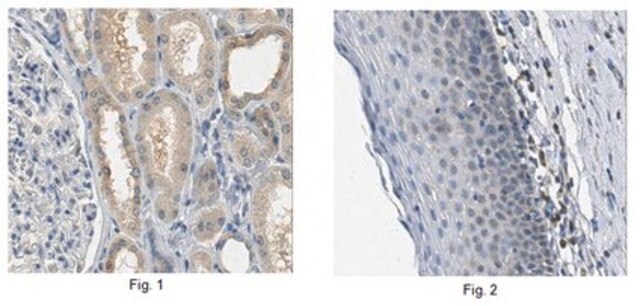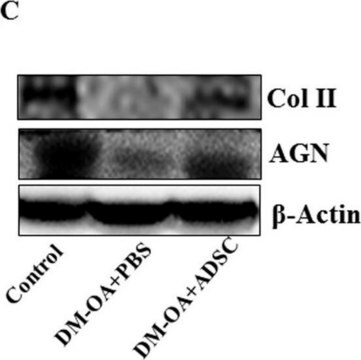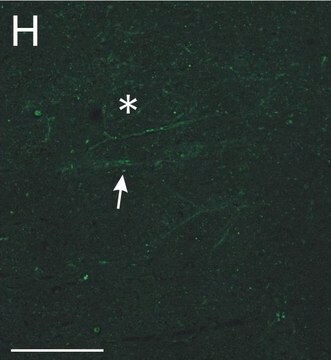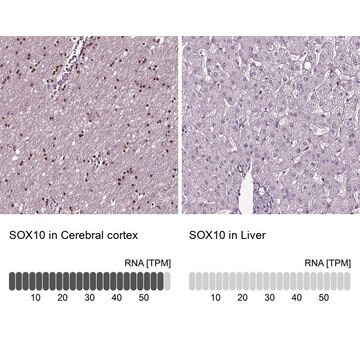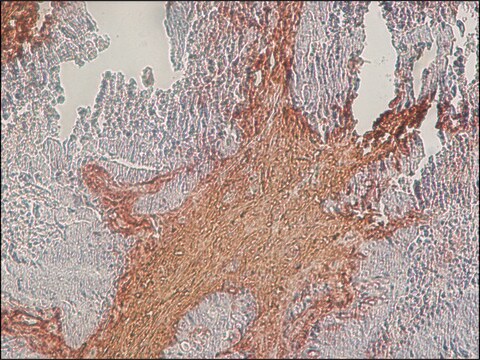General description
We are committed to bringing you greener alternative products, which adhere to one or more of The 12 Principles of Green Chemistry.This antibody is Preservative-free, produced without the harm or sacrifice of animals and exceptionally stable to allow for ambient shipping and storage if needed and thus aligns with "Waste Prevention", "Designing Safer Chemicals" and "Design for Energy Efficiency".
Click here for more information.
ZooMAb® antibodies represent an entirely new generation of recombinant monoclonal antibodies.Each ZooMAb® antibody is manufactured using our proprietary recombinant expression system, purified to homogeneity, and precisely dispensed to produce robust and highly reproducible lot-to-lot consistency. Only top-performing clones are released for use by researchers. Each antibody is validated for high specificity and affinity across multiple applications, including its most commonly used application. ZooMAb® antibodies are reliably available and ready to ship when you need them.
Specificity
Clone 1F16 is a Rabbit recombinant monoclonal antibody that specifically detects Zinc finger protein SNAI1. It targets an epitope within 19 amino acids from the N-terminal region.
Immunogen
KLH-conjugated linear peptide corresponding to 19 amino acids from the N-terminal region of human Zinc finger protein SNAI1.
Application
Quality Control Testing
Evaluated by Western Blotting in HEK293 cell lysate.
Western Blotting Analysis: A 1:10,000 dilution of this antibody detected SNAI1 in HEK293 cell lysate.
Tested applications
Western Blotting Analysis: A 1:10,000 dilution from a representative lot detected SNAI1 in lysates from Human kidney, NIH3T3, and Cos-7 cells..
Immunocytochemistry Analysis: 1:100 from a representative lot detected SNAI1 in NIH3T3 cells.
Affinity Binding Assay: A representative lot of this antibody bound SNAI1 with a KD of 2.9 x 10-8 in an affinity binding assay.
Note: Actual optimal working dilutions must be determined by end user as specimens, and experimental conditions may vary with the end user
Anti-SNAI1, clone 1F16 ZooMAb®, Cat. No. ZRB1433, is a recombinant Rabbit monoclonal antibody that detects Zinc finger protein SNAI1 and is tested for use in, Affinity Binding Assay, Immunocytochemistry, and Western Blotting.
Target description
Zinc finger protein SNAI1 (UniProt: O95863; also known as Protein snail homolog 1, Protein sna, SNAI1) is encoded by the SNAI1 (also known as SNAH) gene (Gene ID: 6615) in human. SNAI1 is expressed in a variety of tissue with highest expression observed in kidneys. It is also expressed in mesenchymal and epithelial cell lines. It contains four C2H2 type zinc-finger domains. SNAI1 is involved in induction of the epithelial to mesenchymal transition (EMT), formation and maintenance of embryonic mesoderm, growth arrest, survival, and cell migration. It has a SNAG domain (aa 1-20) that competes with histone H3 for the same binding site on the histone demethylase complex formed by KDM1A and RCOR1, and thereby inhibits demethylation of histone H3 at lysine 4. During EMT, it is involved with lysyl oxidase like 2 (LOXL2) in negatively regulating pericentromeric heterochromatin transcription. It recruits LOXL2 to pericentromeric regions to oxidize histone H3 and repress transcription, which leads to release of heterochromatin component CBX5/HP1A that enables chromatin reorganization and acquisition of mesenchymal traits. SNAI1 is localized both in the cytoplasm and nucleus. Upon phosphorylation by GSK-3b on multiple serine residues in the N-terminal region, it is it is exported from the nucleus to the cytoplasm where subsequent phosphorylation of the destruction motif and ubiquitination by b-transducin repeat containing E3 ubiquitin protein ligase (BTRC) occurs. Phosphorylation by casein kinase 1e, probably at serine 104, provides the priming site for the subsequent phosphorylation by GSK-3b. Its phosphorylation by p21 activated kinase (PAK1) may modulate its transcriptional activity by promoting increased accumulation in the nucleus. Phosphorylation at serine 11 and serine 92 are reported to positively regulate its functions in the induction of EMT and cell survival, respectively. This ZooMAb® recombinant monoclonal antibody, generated by our propriety technology, offers significantly enhanced specificity, affinity, reproducibility, and stability over conventional monoclonals.
Physical form
Purified recombinant rabbit monoclonal antibody IgG, lyophilized in PBS with 5% Trehalose, normal appearance a coarse or translucent resin. The PBS/trehalose components in the ZooMAb® formulation can have the appearance of a semi-solid (bead like gel) after lyophilization. This is a normal phenomenon. Please follow the recommended reconstitution procedure in the data sheet to dissolve the semi-solid, bead-like, gel-appearing material. The resulting antibody solution is completely stable and functional as proven by full functional testing. Contains no biocide or preservatives, such as azide, or any animal by-products. Larger pack sizes provided as multiples of 25 μL.
Reconstitution
300 μg/mL after reconstitution at 25 μL per vial. Please refer to guidance on suggested starting dilutions and/or titers per application and sample type.
Storage and Stability
Recommend storage of lyophilized product at 2-8°C; Before reconstitution, micro-centrifuge vials briefly to spin down material to bottom of the vial; Reconstitute each vial by adding 25 μL of filtered lab grade water or PBS; Reconstituted antibodies can be stored at 2-8°C, or -20°C for long term storage. Avoid repeated freeze-thaws.
Legal Information
ZooMAb is a registered trademark of Merck KGaA, Darmstadt, Germany
Disclaimer
Unless otherwise stated in our catalog or other company documentation accompanying the product(s), our products are intended for research use only and are not to be used for any other purpose, which includes but is not limited to, unauthorized commercial uses, in vitro diagnostic uses, ex vivo or in vivo therapeutic uses or any type of consumption or application to humans or animals.

